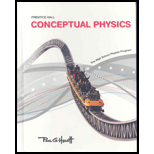
Four satellites in circular orbit about Earth have the following characteristics:
(A)
(B)
(C)
(D)
a. Rank the satellites' orbital speeds from greatest to least.
b. Rank the satellites' times for orbiting Earth from greatest to least.
c. Does mass affect your answers to parts (a) and (b)?
(a)
To rank:The satellite’s orbital speed from greatest to least.
Answer to Problem 21A
The rank of the satellite’s orbital speed from greatest to least is
Explanation of Solution
Given:
Four satellites characteristics are:
Formula used:
The expression for orbital speed is,
Here,
The expression for the radial distance is,
Here,
Calculation:
Consider the radius of Earth as
The orbital speed for case A is,
The orbital speed for case B is,
The orbital speed for case C is,
The orbital speed for case D is,
Comparing the values of the orbital speed
Conclusion:
Thus, the rank of the satellite’s orbital speed from greatest to least is
(b)
To rank:The satellite’s time for orbiting Earth from greatest to least.
Answer to Problem 21A
The rank of the satellite’s time for orbiting Earth from greatest to least is
Explanation of Solution
Given:
Four satellites characteristics are:
Formula used:
The expression for time for orbiting Earth is,
Here,
The expression for the radial distance is,
Here,
Calculation:
Consider the radius of Earth as
The time for orbiting Earth for case A is,
The time for orbiting Earth for case B is,
The time for orbiting Earth for case C is,
The time for orbiting Earth for case D is,
Comparing the values of the time for orbiting Earth
Conclusion:
Thus, the rank of the time for orbiting Earth for the three circular orbits from greatest to least is
(c)
Whether the mass will affect the satellite’s orbital speed and time for orbiting Earth.
Answer to Problem 21A
The mass does not affect the satellite’s orbital speed and time for orbiting Earth.
Explanation of Solution
Given:
Four satellites characteristics are:
Formula used:
The orbital speed is,
The time for orbiting Earth is,
Here,
Calculation:
Both, orbital speed and time for orbiting Earth, are related to the Earth’s mass and the radial distance of the orbit.But the expression for the orbital speed as well as for the time to orbitEarth are independent of the mass of satellite.
Hence, the mass does not affect the satellite’s orbital speed and time for orbiting Earth.
Conclusion:
Thus, the mass does not affect the satellite’s orbital speed and time for orbiting Earth.
Chapter 14 Solutions
Conceptual Physics: The High School Physics Program
Additional Science Textbook Solutions
College Physics (10th Edition)
University Physics Volume 2
Tutorials in Introductory Physics
Lecture- Tutorials for Introductory Astronomy
Physics: Principles with Applications
Conceptual Physical Science (6th Edition)
 College PhysicsPhysicsISBN:9781305952300Author:Raymond A. Serway, Chris VuillePublisher:Cengage Learning
College PhysicsPhysicsISBN:9781305952300Author:Raymond A. Serway, Chris VuillePublisher:Cengage Learning University Physics (14th Edition)PhysicsISBN:9780133969290Author:Hugh D. Young, Roger A. FreedmanPublisher:PEARSON
University Physics (14th Edition)PhysicsISBN:9780133969290Author:Hugh D. Young, Roger A. FreedmanPublisher:PEARSON Introduction To Quantum MechanicsPhysicsISBN:9781107189638Author:Griffiths, David J., Schroeter, Darrell F.Publisher:Cambridge University Press
Introduction To Quantum MechanicsPhysicsISBN:9781107189638Author:Griffiths, David J., Schroeter, Darrell F.Publisher:Cambridge University Press Physics for Scientists and EngineersPhysicsISBN:9781337553278Author:Raymond A. Serway, John W. JewettPublisher:Cengage Learning
Physics for Scientists and EngineersPhysicsISBN:9781337553278Author:Raymond A. Serway, John W. JewettPublisher:Cengage Learning Lecture- Tutorials for Introductory AstronomyPhysicsISBN:9780321820464Author:Edward E. Prather, Tim P. Slater, Jeff P. Adams, Gina BrissendenPublisher:Addison-Wesley
Lecture- Tutorials for Introductory AstronomyPhysicsISBN:9780321820464Author:Edward E. Prather, Tim P. Slater, Jeff P. Adams, Gina BrissendenPublisher:Addison-Wesley College Physics: A Strategic Approach (4th Editio...PhysicsISBN:9780134609034Author:Randall D. Knight (Professor Emeritus), Brian Jones, Stuart FieldPublisher:PEARSON
College Physics: A Strategic Approach (4th Editio...PhysicsISBN:9780134609034Author:Randall D. Knight (Professor Emeritus), Brian Jones, Stuart FieldPublisher:PEARSON





